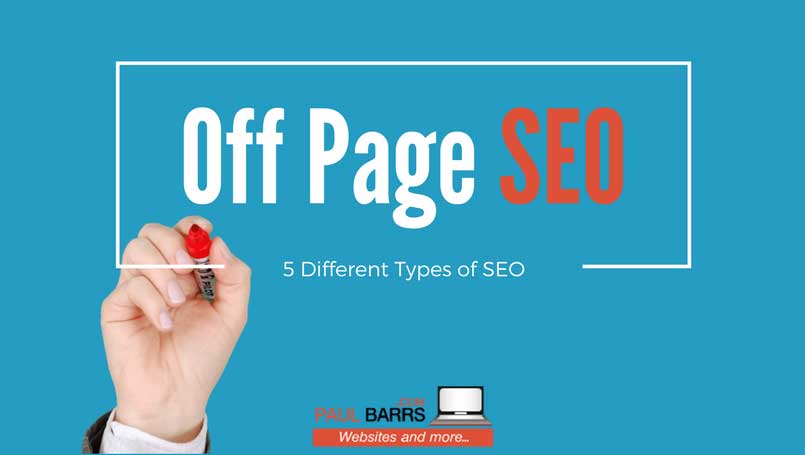
15 Aug Off Page SEO (5 Different Types of SEO Pt 2)
Today we’re looking at the Off-Page side of SEO. Slightly more detailed than ON-Page, but well worth the time and effort of getting it right.
Hi there, folks. It’s Paul Barrs, signing back in for another quick video on the main things you can do to improve the SEO results from your website. Now, with the previous video, we spoke about the on-page side of things. In this video, number two, we’re looking at the off page side of things. Oh, boy, what a nightmare, what a huge topic we’ve got here. Let’s see if I can break it down just to give you an understanding of the different things that you can be looking at, focus on making them work for your site.
Traditionally, when we think of off page SEO, we think of back linking, generating links back to your website from others. And yes, that is the core of it. It is the most essential important element of it, and probably, in all areas of SEO. But here is the thing, unless the content on your website, what we spoke about in number one, is really good, why would people bother linking back to you. So, what I’m going to do in this video is look at a couple of different types of links back to you that can be beneficial.
Firstly, I guess the easiest, directory links. Particularly if you’re a small business working in that local SEO area. There are literally dozens and dozens of places where you can acquire links from business directories back to your website. And these can be good for you not just from a local SEO point of view, but also people, probably, use these directories and might well find you there as well. So, of course, each listing must be optimized for best results.
Then, number two, there is that area of SEO which is generating back links for quality content. Now, I spoke about in the first video, you having good cornerstone content pages, in-depth articles, and this is not just good for your customers but because people are going to want to link to them.
And here’s my question for you. If you don’t have yet any content like this on your website substantial enough that people are going to want to link to it, why not? Why not write some? Is it not possible in your business, in your industry to have something which is in-depth, explaining what you do, the good, the bad, the ugly, the what, the why, the when? Can you not do something for this and then go looking for links to come back to your website?
Nine times out of ten, I know you can. And that is a very important part of SEO to your authority articles.
Then, there is that lightest side of link building where, oh, this is the difficult one. People have made entire careers out of just building back links, and all they do is get these links from wherever back to your website, back to your website, back to your website, usually crap, usually rubbish. So what we have to do is look for opportunities to make them worthwhile.
Now this, of course, comes back to the content mix. And there are couple of things, let me just give you a few strategies. Number one, if you do have good content, you can go and outreach to get people to link back to you. That’s great. Another great idea is to look for broken links on other people’s websites to, say perhaps, a competitor. And you can do this with link building tools and link analysis tools. Drop your competitor into the tool and go find me broken links, back to their website. And then you can approach those websites and say, “Hey, what don’t you link to us and link to this piece of content.” That’s a brilliant way to go finding new link opportunities.
Another way is through content outreach. Let me write something for you to go onto your website, which of course will link back to me. And you’re probably learning from all of these things, you guess these are time consuming. Not much we can do about that. Good quality links do take time to build. And that’s why often SEO can cost so much.
Another good idea is to have a look at, we mentioned before earlier, the link directories and, sorry, not link directories, the business directories. Good quality ones, let me emphasize that. Look for ones who are linking to your competitor, choose, say, one competitor, find some major site that link to it but not to you. Ask yourself a question, “Why?” And then, get them to also link to you.
Focus on authority sites when you’re doing these things, things with good demeanor authority. And as you do it, yes, have a strategy. Yes, it takes time. Yes, it takes money. I’ve got a couple of videos on how long does SEO take, how much does SEO cost. Have a look at those to grasp the big picture.
The point being this, once you’ve done your technical SEO, once you’ve got your on-page content SEO in place, the only two things you should spend your time doing is adding to that content and getting people to link back from there websites to yours to that content. That’s your SEO strategy. And that’s why when someone says, “Hey, it’s going to cost $500, $700, $1,000 a month or more.” For an effective campaign, it costs that much because of the time it takes.
Let me finish this video with a quick warning. We had a client come to us recently and say, “I’ve got a problem. I’m paying someone, and I’ll say it, in India to do my back linking for me. And I’ve been doing it for six months and it’s costing me, you know, $250 a month. And it’s affordable, and I just don’t think it’s doing anything for me.” So I jumped in and had a quick look around. Here’s what I found.
Number one, the links that they were creating were absolutely rubbish on other websites back. Number two, those links were part of a link portal of some sort, all sites linking to each and from each other, and just making a mess. And number three, which absolutely shocked me, that people still do this on the backend, hidden away in this person’s website was a link PHP file. Now, that’s just my terminology. What I mean was it was a PHP file that you would . . . it automatically updates them.
When we go to link, we punched in, “I want that site to link from me,” and it updated the 1,200 links on that page of other sites linking to it and it linking to those other sites. Basically, these people had created a link scheme of nothing but, we link to you, you link to us. I don’t think any more than four or five of the sites in that 1,200 were even related to the topic or content of this particular customer. And it was all automatic and it was all generated through crappy code and it was absolutely horrible.
First thing I did was just get rid of all that. And then we began some good on-page SEO, some technical SEO. Next month coming up, we’re still doing it. We’re going to be doing their off-page directory SEO and going from there.
Here’s the thing, there is a lot to off-page SEO. If you can do it yourself, great. But if you’re going to outsource it to somebody else, you better know what they’re doing and you better keep track of it to make sure they’re not screwing you over and putting you in bad light with Google.
My name is Paul Barrs, signing off from this video. I’ll talk to you again in the next one. See you then. Bye-bye.


